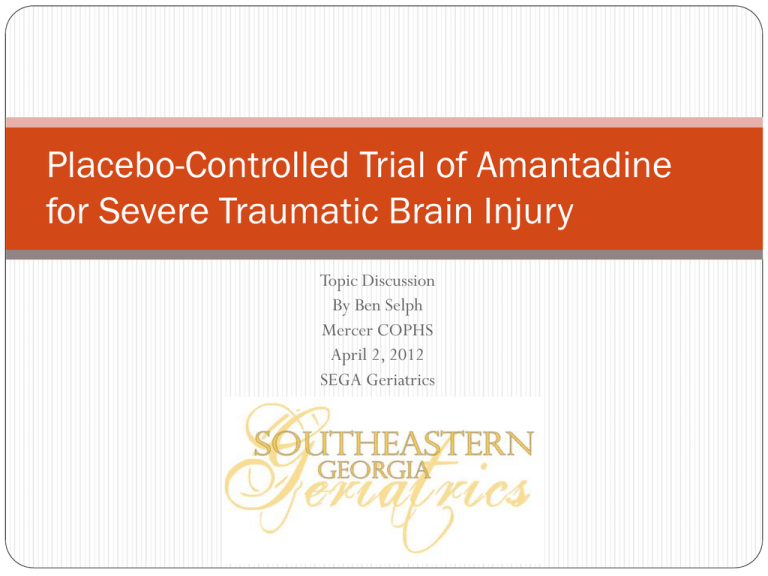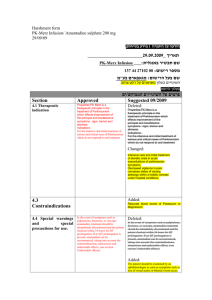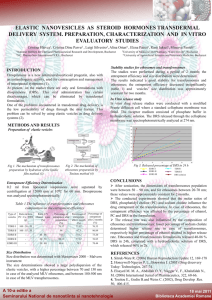Placebo-Controlled Trial of Amantadine for Severe Traumatic Brain
advertisement

Placebo-Controlled Trial of Amantadine for Severe Traumatic Brain Injury Topic Discussion By Ben Selph Mercer COPHS April 2, 2012 SEGA Geriatrics Background Information Traumatic brain injury—most common cause of death and disability in persons between 15 and 30 years of age. Severe injuries can result in prolonged disorders of consciousness. Vegetative state for at least 4 weeks: approximately 50% will regain consciousness by 1 year. Outcomes generally more favorable for minimally conscious state, but approx. 50% remain severely disabled at 1 year. No intervention has been shown in rigorous studies to alter the pace of recovery or improve functional outcomes. Amantadine hydrochloride Mechanism of action: precise mechanism is unknown, but believed to inhibit NMDA receptors, block reuptake of dopamine into presynaptic neurons, and increasing dopamine release from presynaptic nerves. Uses: parkinsonism, drug-induced EPS Also used to treat influenza: blocks M2 ion channel to prevent viral uncoating. Dosage: generally 100 mg BID, can increase to 300-400 mg/day in divided doses. Common side effects: confusion, dizziness, dry mouth, and hallucinations, orthostatic hypotension, edema, abnormal dreams. Study Multicenter, prospective, double-blind, randomized, placebo- controlled trial Purpose: determine the effectiveness of amantadine in promoting recovery from a post-traumatic vegetative or minimally conscious state. Hypothesis: 4 weeks of treatment with amantadine administered between 4 and 16 weeks after injury in patients with traumatic disorders of consciousness would improve the rate of functional recovery during the treatment interval, that improvement would be maintained 2 weeks after washout, and that amantadine would be well-tolerated. Methods Eligible patients: Age 16-65, had sustained a nonpenetrating traumatic brain injury 4 to 16 weeks before enrollment, and were receiving inpatient rehab at each site. Additionally, either in a vegetative or minimally conscious state indicated by DRS score greater than 11, and an inability to both follow commands consistently and to engage in functional communication assessed by CRS-R Exclusion criteria: Any disability to CNS that predated the injury, medical instability, pregnancy, serious renal disease (<60 ml/min), more than one seizure in previous month, prior treatment with amantadine, and allergy to amantadine. Methods cont’d Patients randomized to receive either amantadine or visually identical placebo. Procedure: started on 100 mg twice a day for 2 weeks, then increased to 150 mg twice a day at week 3 and to 200 mg twice a day at week 4 if no improvement in DRS score by at least 2 pts. List was made of confounding medications, from least to highest, and physicians requested to follow the order. Primary outcome: rate of improvement in the DRS during the 4 weeks of treatment Effects of amantadine assessed by scores on the CRS-R Results Primary outcome: both groups had significant improvement in the DRS score over the 4-week treatment interval, but the amantadine group had significantly faster recovery (difference in slope, -0.24 points per week, P=0.007) In both study groups, patients enrolled earlier (28-70 days) vs. later (71-112 days) after injury and those who were in a minimally conscious state rather than vegetative at enrollment had faster recovery rates. But the treatment effect was consistent across subgroups. Advantage of amantadine was most pronounced in patients who enrolled later as compared with those who enrolled earlier. Results New England Journal of Medicine, 2012; 366:819-826. Supplementary Index. Results New England Journal of Medicine, 2012; 366:819-826. Supplementary Index. Results cont’d More patients in the amantadine group than placebo group had favorable outcomes on the DRS, fewer remained in a vegetative state after 4 weeks (A-18.6%; P-31.6%), and a greater percentage had recovery of key behavioral benchmarks on CRS-R. Moderately severe to severe (after 4 weeks): A-55.8%; P-51.6% During the 2-week washout period, only placebo group had significant improvement in the DRS score (slope, -0.44 points per week; p<0.001) Behavioral improvements maintained, but pace was slower in the amantadine group. Adverse events—no significant difference in the incidence between groups. Discussion What does the study show? Amantadine, given between 4 and 16 weeks after injury, improved the rate of functional recovery over the 4-week period of treatment compared to placebo. Both groups saw an improvement in function, but the amantadine group had a faster rate of recovery. Amantadine effect on function was consistent regardless of interval since injury or whether patient in vegetative state or minimally conscious. Gains in functioning were maintained through washout, but rate dropped significantly. Scores on DRS largely indistinguishable between groups after 6 weeks. Results match observational reports. Discussion Is the study valid? Prospective, double-blind, placebo-controlled Multicenter (11 clinical sites in 3 countries) *however, predominantly white patients in both groups (84% and 90%) Enough patients enrolled (184) to give 80% power to detect difference in rate of change of DRS score of 0.3 points per week. *Duration was long enough to see a causal relationship, but not long enough to get a long-term outcome results. Patients treated similarly, and results matched objectives. Discussion Limitations Selection bias?—patients were admitted to inpatient rehab centers (influenced by probable further development?) Also majority of patients were white, limiting ability to generalize results. Findings do not address effects of prolonged treatment on long- term outcomes. (practical and ethical constraints) Hard to determine degree of benefits seen from amantadine due to other medications used, if amantadine effects were independent or synergistic with standard treatments. Conclusion While the study shows that amantadine increases the rate of functional recovery of patients with TBI, it doesn’t show long-term effects of using amantadine. Majority of patients at end of 4 weeks were still in the 14-up range of DRS (severe-vegetative). Unknown whether amantadine improves long-term health outcomes or just speeds up recovery to the same level. Future studies should be done to investigate the appropriate dose, effective duration to see if it improves long-term outcomes, and appropriate timing of administration. Level of Evidence: Class IIa, Level B References Giacino JT, et al. “Placebo-controlled Trial of Amantadine for Severe Traumatic Brain Injury.” N Engl J Med Mar 1, 2012; 366:819-826.



![Critical Incident Reporting System [CIRS]](http://s2.studylib.net/store/data/005482755_1-7eaadf4b265b8b8b33444fd62a05b4f9-300x300.png)


